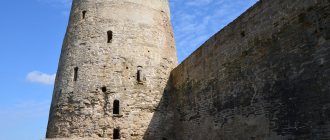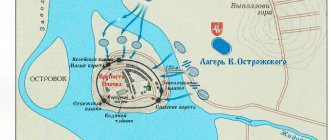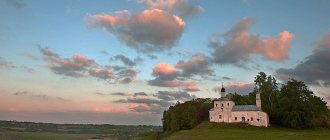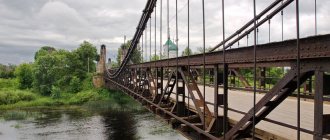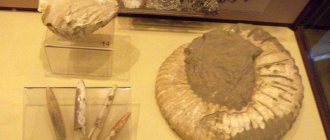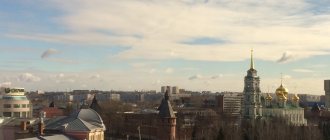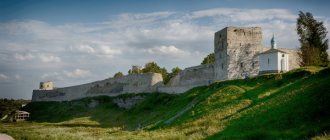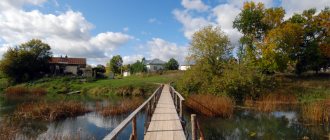The Izborsk Museum-Reserve is one of the most popular tourist sites in the Pskov region. Izborsk is not just a settlement, but a unique corner where nature is an amazing unity with people, and the result is a successful symbiosis of the creations of human hands and natural wonders. Nowadays, on the territory of the museum-reserve, a natural landscape department, a scientific fund and scientific departments have been created in order to study and show visitors the nature and history of this wonderful place as best as possible.
Description and history of Izborsk
Izborsk is a village in the Pechora district of the Pskov region, which is part of the urban settlement "Pechory". This is one of the oldest Russian settlements, which in ancient times was considered a city. Fewer than 800 people live here, but there are a large number of attractions that attract tourists. Its second name is Old Izborsk (in contrast to the village of New Izborsk).
Izborsk is a separate settlement, but is part of the city of Pechora
Izborsk is located in the western part of the Pskov region (30 km from Pskov) near Lake Gorodishchenskoye.
The settlement was first mentioned in the Tale of Bygone Years (862) as a suburb of Pskov. It is believed that Sloven (son of Gostomysl) became its founder. At first, Izborsk was adjacent to Polotsk and was ruled by governors, and in the 10th century it became a separate settlement, in the center of which there was a detinets (inner city fortress), fenced with a high oak wall. Craftsmen lived in posad (on the outskirts of the city). The settlement was also protected, but by a clay rampart and a stone wall.
In the 20th–13th centuries, Izborsk was often besieged by German knights, it burned and collapsed. In 1330, the fortress city was rebuilt on Crane Mountain. Until the 15th century it was besieged 8 times. In 1510, Izborsk became part of the Moscow Principality. In 1581, the fortress was captured by the Polish-Lithuanian Commonwealth, but a year later it was returned to Moscow.
At the beginning of the 18th century, Izborsk became part of the Ingermanland province, which soon became St. Petersburg. Later, the Pskov province emerged in the renamed region, to which Izborsk began to belong in 1777.
During the Great Patriotic War, the city was captured by the Germans and was subordinate to the Reichskommissariat Ostland; it was returned only in January 1945. Since 1996, Izborsk has been a tourist center and nature reserve.
A scandal broke out in the Pskov-Izborsk Museum
Pskov residents wrote an appeal to the museum and city administration and collected signatures for a petition. It says that “the decision of the administration of the Pskov Museum causes distrust and has disastrous consequences, all the more obvious at the height of the tourist season.” However, instead of a clear answer, we received a reply. Now we are ready to reach the president. “MK” understood the situation.
The Ludwig Mason House, named after one of the owners, a French teacher, closed on June 1. The reason for the closure was renovations in other buildings of the museum complex (there are 21 objects under its management), the museum management and the regional administration explained, but here’s what’s strange.
Restoration of the buildings began in 2021, and the Masonic House operated safely for two years, and now that the work is close to completion, a move has been arranged. The head of the department of scientific and fund work of the museum-reserve, art critic Olga Vasilyeva told MK about the situation from the inside.
“Since 2021, the main buildings have been closed for restoration, while the storage facility in the Mason’s House has been open to visitors,” says Olga Anatolyevna. – And on June 1, the Masonic House was closed, just at the moment when we had additional space in the Postnikov Courtyard, where restoration was completed, and two more objects are to be opened at the end of the year - these are the Pogankin Chambers and the building of the Fan der Vleet School of Art and Industry .
But instead of moving the large fund of unrestored icons there, they decided to close the Masonic House. But we opened it in 2006, and it was the second (after the “Old Village” of the Hermitage) open storage facility in Russia; moving it was difficult, because all the items had to be packed, unpacked, described - the storage system requires a clear topography.
Through experimentation we created this open storage. And now we need to move the fund of unrestored icons, which now occupy an area of 225 sq.m., into two small halls of 90 sq.m. in the Masonic House. This is the largest collection in the world of Pskov monuments of the 14th-18th centuries, for the preservation of which it is necessary to create optimal conditions. Now these icons are in better conditions than those to which they are supposed to be transported.
– Among these icons is the famous icon of the martyr Ulyana - a monument of the 16th century, which has not been restored for 30 years. Why?
– The situation with Ulyana is one of the indicators of our life. Several years ago it was said that by 2021 it would definitely be on display, but nothing has been done yet. We have a unique fund of Pskov icons, which numbers more than a thousand items; we have two full-time tempera restorers with diplomas from the Repin Institute of the Academy of Arts. But only one works at a quarter rate.
- These are administration problems. When in 2021 it was necessary to move the collection of icons from one room to another, the situation was also brought to the point of absurdity: they delayed it so much that the evacuation of the collections took place amid collapses of plaster. Now the situation is repeating itself in a different version.
– Why can’t the public or the city administration influence the situation?
– When we were, until recently, under the leadership of the regional committee for culture, we could find a more or less adequate reaction, there was some kind of feedback. Something was somehow being resolved.
— On January 1, we became a federal museum, and our appeals to the Ministry of Culture remain unheeded. The situation with the closure of the storage facility caused widespread confusion, we worked very actively, we held concerts and various programs. In the depository we conduct excursions and give lectures, the number of which in certain months was greater than in other departments. I know that concerned Pskovites wrote several open letters to a number of authorities, including the Ministry of Culture, but nothing. I don’t understand why break something that has been working for 15 years?
Now the concerned public and museum workers are going to appeal directly to the president of the country, since in response to letters they receive only unsubscribes. MK will monitor the situation.
How to get to Izborsk
There are several ways to get to Izborsk:
- by bus (No. 207 or No. 126) from Pskov from the bus station (Vokzalnaya Street, 21) or from Pechory from the bus station (Pobeda Square, 2);
- by train from St. Petersburg, Moscow and other cities with a transfer to a bus in Pskov;
- by car in a westerly direction from Pskov or St. Petersburg along the E95 highway (P-23) or along the M9 highway from Moscow;
- by plane from Moscow, St. Petersburg, Rostov-on-Don, Krasnodar, Sochi, Voronezh, Kaliningrad, Saratov and other cities with a transfer to a bus in Pskov;
- by taxi from any city (the cost of travel from the Pskov bus station to Old Izborsk is on average 500–800 rubles).
From the Novgorod and Leningrad regions you can get to Izborsk through Pskov, and from the Moscow region - through Pustoshka, Opochka and Ostrov
Common features
The Pskov-Izborsk Museum-Reserve is in many ways similar to the Vladimir-Suzdal Museum. There, as in region 33, a historical retrospective was created related to the ancient Russian state, its defense, its heroes; there are unique architectural monuments.
Pskov-Izborsk Museum-Reserve. Photo: museumpskov.ru
The museum includes the Pogankin Chambers (XVII century), the building of N.F. Fan der Fleeta, Order Chamber (XVII century), Spaso-Preobrazhensky Cathedral of the Mirozh Monastery (XII century). The Pskov Museum is the custodian of unique monumental paintings of the Transfiguration Cathedral (XII century) of the Mirozhsky Monastery, the Church of the Assumption of the Mother of God in the village of Meletovo (XV century), the chapel of St. Anastasia in Pskov with frescoes from the school of N. Roerich.
In the art gallery of the Pskov Museum you can see paintings by K. Bryullov, V. Tropinin, I. Shishkin, I. Aivazovsky, A. Kuindzhi, N. Ge, V. Makovsky, I. Repin, K. Yuon, A. Vasnetsov, N. Roerich, K. Petrov-Vodkin, R. Falk, M. Chagall and many other famous artists.
State Historical-Architectural and Natural Landscape Museum-Reserve "Izborsk"
The small village has gained tourist popularity thanks to its ancient architectural monuments and recently established museums. All the buildings in Izborsk that are offered for inspection smell of antiquity. In fact, the entire village and its surroundings are part of the Izborsk State Historical-Architectural and Natural Landscape Museum-Reserve.
Izborsk fortress
Although the Izborsk fortress was built in the 14th century, it has almost entirely survived to this day. Only part of the protective structure was restored. Interestingly, this fortress was originally built of wood, but a few years later the structure was reinforced with stone. The Izborsk fortress ceased to serve as a fort after the Northern War. For several centuries the buildings were in a deplorable state, but in 1842, Russian Emperor Nicholas I ordered repairs.
Currently, the fortress is part of the Izborsk Museum-Reserve; research work is being carried out on the territory, and its technical condition is constantly monitored. Tourists may be interested in the following objects:
- tower with observation deck - Lukovka;
- Talav Tower (Talavi Zahab) - it is believed that it was named after the Tolova, Talab tribe, which inhabited these lands in ancient times;
- towers Temnushka (an unusual name was given to it because of the small amount of light inside) and Ryabinovka (so named because a rowan grove grew nearby) 15 and 16 m high, respectively;
- Vyshka tower (height - 19 m, was higher than other towers thanks to the wooden superstructure);
- Bell Tower (previously there was a two-span belfry on which hung a bell, which was dismantled in the 19th century);
- Flat Tower (Ploskushka);
- St. Nicholas Cathedral;
- western fortress wall.
The area of the territory enclosed by the fortress walls is 2.4 hectares, the total length of the stone walls reaches 850 m, their thickness is up to 3 m.
Information for tourists:
- address: Pechorskaya street, 39;
- Opening hours: any day from 9:00 to 18:00;
- ticket prices: children - 30 rubles, reduced rates (students, pilgrims, pensioners) - 50 rubles, adults - 100 rubles.
Cathedral of St. Nicholas the Wonderworker
The Cathedral of St. Nicholas the Wonderworker ( Nikolsky) was built in the first half of the 14th century. Together with the fortress and the temple of Sergius of Radonezh and Nikander, it formed the urban center of medieval Izborsk. The first mention of the temple dates back to 1341. At that time, the cathedral was located at the very gates of the fortress (he moved here, to Crane Mountain, along with the old fortress). True, in the Middle Ages the cathedral was called the house of St. Nicholas.
Among my friends there is a woman who has long been interested in the history of religion in Russia. She told me that according to one theory, St. Nicholas was the patron saint of all farmers and hard workers. He also defended all the oppressed and the right. This is supposedly why many ancient churches are named after St. Nicholas.
At first, St. Nicholas Cathedral was monolithic (cubic), but later (in the 19th century) a southern aisle and a bell tower were added to it. The entire structure is made from local stone, and there are no lush decorative elements. Even after years, temple servants and local authorities try not to destroy the ancient architectural style. The modeling of the building is archaic, the apse (lowered projection of the building) is smooth, there are windows in the form of loopholes and a hemispherical dome. Of course, there is no sophistication in such a building, but there is austerity and softness characteristic of the works of Russian architects.
The chapel of the cathedral was erected in the 16th century instead of the wooden Church of the Transfiguration of the same name built in 1349
Information for tourists:
- St. Nicholas Cathedral is located on the territory of the Izborsk fortress;
- You can come here every day from 9:00 to 18:00;
- visiting is free.
Museum Quarter
In 2012, three restored estates were united into a museum quarter, and exhibitions were organized in the buildings themselves.
House of Merchant Shvedov - Museum of the Seto People
The House of Merchant Shvedov is the main house of a 19th-century estate that belonged to a linen merchant. The museum-reserve uses this building for the exhibition “Russians and Seto. One land, common history."
Seto (Seto) is a people who were once called the Pskov Chud. There is a version according to which the Seto received their nickname due to their close location to Lake Peipsi. Representatives of this people gave preference to agriculture, so they were not particularly concerned about the lake, and the Russians, for whom fishing was important, gradually pushed the Seto aside. It so happened that the peoples mixed and the “Pskov miracle” could have completely disappeared.
In Izborsk they decided to preserve the memory and culture of the ancient people by creating an ethnographic exhibition about the Seto people in the 19th century. The exhibition includes the following exhibits:
- clothes and jewelry made from natural materials (wool, linen, rags, ribbons);
- merchant household items and ancient photographs;
- an ethnographic collection collected in the Pechora region over the past 30 years;
- a collection of factory samovars (Batashev, Teile, Gornin factories) and handicrafts;
- a collection of labor tools, spinning wheels, including working ones, as well as household and ceremonial towels;
- traditional folk costumes of Russians and Seto.
The harmonium donated to the museum was produced by the German Hermann Burger factory in 1872.
Tourist information:
- address: Pechorskaya street, 32;
- Opening hours: daily from 10:00 to 18:00;
- Ticket price: adult - 150 rubles, children - 50 rubles, student - 100 rubles.
House and outbuilding of merchant Anisimov
The exhibition, which is located in the ancient two-story house of merchant Anisimov, is a local history exhibition. The official title of the permanent exhibition is “Chronicle of the Slavic-Russian princely city of Izborsk: from the beginning of Russia to the Battle of Poltava.” The uniqueness of this exhibition is that only here are presented some exhibits dating back to the era of the city’s birth. Main exhibits:
- stone crosses of the “Izborsk type” (monuments of ancient Russian paleography);
- authentic examples of defensive and offensive weapons;
- samples of rider and horse equipment;
- reconstructed sets of complete military equipment;
- weapons of Russian warriors from different eras;
- weapons of the knights of the Teutonic and Livonian Orders;
- ammunition of a Polish warrior;
- archaeological collection;
- works of the artist P. D. Melnikov, etc.
A local historian I know, Thomas, told me how objects that belonged to the Teutonic knights ended up in Russia. The order was created in 1199. Its founders planned to develop their brotherhood to the level of the Templars, so the necessary papers and rules were drawn up. Brotherhood members were expected to live in poverty, help the weak and protect the wounded. But later the Teutonic Order began to lay claim to neighboring lands. The crusaders, weakened, unprepared and wearing heavy armor, went to war again and again, but did not always win. Russians know from the school curriculum about the Battle of the Ice (when Alexander Nevsky defeated the army of the crusaders, and they went under the ice).
You can look at real knightly armor with your children.
The exhibition “Chronicle of the Slavic-Russian princely city of Izborsk: from the beginning of Russia to the Battle of Poltava” is divided into 2 halls
Information for tourists:
- address: Pechorskaya street, 41a;
- Opening hours: daily from 10:00 to 18:00;
- Ticket prices range from 50 to 150 rubles.
Exposition of paintings “Izborsk Chamber of Russian Literature and Orthodox Faith”
In the outbuilding of the merchant Anisimov’s estate there is an exhibition “Izborsk Chamber of Russian Literature and the Orthodox Faith.” The author of all the paintings presented at this exhibition is People's Artist of the USSR and Honorary Citizen of Pskov Pyotr Ossovsky. The paintings are mainly dedicated to the lives of two great figures of Russian history and culture who lived and worked on the ancient Pskov-Izborsk land:
- Princess Olga, who made a great contribution to the development of Orthodoxy in Rus' and, according to legend, was born near Pskov;
- Alexander Pushkin, who can be called one of the creators of the modern Russian language and whose fate is connected with Mikhailovsky (a village near Pskov).
Some works are dedicated to churches, revered elders and teachers of the Orthodox Church. There are other exhibitions in adjacent rooms (antiques, local history materials, etc.).
Photo gallery: different sections of the exhibition “Izborsk Chamber of Russian Literature and Orthodox Faith”
The ideological center of the entire chamber is the paintings dedicated to Princess Olga and Pushkin, whose life and work are inextricably linked with the ancient Pskov-Izborsk land
A number of paintings are accompanied by texts written by Valentin Kurbatov, which, according to Ossovsky’s plan, should contribute to a deeper perception of his paintings
All the paintings presented at the exhibition are connected by one idea.
“Blagovest” depicts a monk-ringer symbolically performing a solemn ringing, the silent sounds of which echo over the Izborsk fortress
The painting “The Road to the Temple” is dedicated to the return of the Orthodox faith to Russian soil
Information for tourists:
- address: Pechorskaya street, 41b;
- Opening hours: daily from 10:00 to 18:00;
- Ticket prices range from 20 to 100 rubles.
Exposition “Gate of High Russian Style”
In one of the buildings of the merchant Anisimov’s estate there is another exhibition “The Gates of the High Russian Style” - this is an exhibition dedicated to the 400th anniversary of the House of Romanov. The visitor is invited to view the following exhibits:
- sketches of paintings for the chapel of St. Anastasia in Pskov;
- frescoes dedicated to the Feodorovsky Sovereign Cathedral;
- works dedicated to the Society for the Revival of Artistic Rus';
- copies of the disappearing frescoes of the Feodorovsky town in Tsarskoe Selo;
- photographs of the Chambers of the Romanov Boyars of the late 15th century;
- photographs of the family of Emperor Nicholas II, etc.
The special pride of the exhibition is the items associated with the “Feodorovsky town” (Fedorovsky, Russian). “Russian Town” is an architectural complex built in the 20th century. These buildings are also called clergy houses. The complex was built as a museum object, but it is managed by the Tsarskoe Selo deanery (since it is located not far from Tsarskoe Selo). Sketches of future houses were approved by the last Russian Tsar Nicholas II.
The exhibition project is part of the exhibition “Izborsk - Holy Places for Russian Culture”, which is being worked on by employees of the State Historical-Architectural and Natural Landscape Museum-Reserve “Izborsk”
Truvorovo settlement
Truvorovo (Izborskoye) settlement is a place where there was a small settlement in the 7th–18th centuries. The settlement was founded by the Krivichi and is occupied by Slavic (wooden) and non-Slavic (with clay floors) houses. Nearby there is an ancient cemetery with stone crosses from the 15th century. The name of the settlement came from this cemetery.
One of the large stone crosses in this cemetery is called Truvorov (above Truvorov’s grave). There is no exact historical evidence, but old-timers believe that this name is associated with the ancient Varangian Truvor, the legendary brother of Rurik, who was called to reign in Novgorod. Empress Catherine II also believed in this legend. She ordered the printing of a medal, on the tail of which was written “Truvor died in Izborsk in 864.” By the way, Gorodishchenskoe Lake is named after the Truvorov settlement.
Truvorovo settlement is located on the triangular cape of Zhuravya Mountain at an altitude of 48 m. The total area of the object is 1 hectare. Under the site there is a protective earthen rampart 6 m high and a ditch 3 m deep.
Several crosses have been preserved at the Gorodische cemetery; near Truvor’s grave there is a sign with the corresponding inscription
Information for tourists:
- Truvorovo settlement is located next to the Izborsk fortress;
- Free admission.
Korsun Chapel
The Korsun Chapel was built in 1929–1931 (presumably) on the site of an old burial ground. The construction project was drawn up by the architect Alexander Vladovsky (this is indicated on the wall of the chapel). According to legend, the chapel stands on the site where there used to be a mass grave of soldiers who defended the Izborsk fortress in 1657. The chapel is named after the icon of the Korsun Mother of God, painted by Pimen Sofronov.
There is a legend about how the city was saved. In 1685, the Germans attacked Izborsk. It was planned to capture the fortress, but Evdokia (a local widow) found out about this. She locked herself in her cage, placing an icon in front of her, and prayed all night. Then the woman told how the face on the icon streamed myrrh. The cleric Simon, and later Archbishop Macarius, learned about the miracle. For forty days prayers were sung near the icon, and the enemy retreated. Since then, Izborians have honored the icon of the Korsun Mother of God.
A small bright chapel stands near the Talavskaya (square) tower of the Izborsk fortress. It looks contrasting against the background of the gray fortress walls, but local authorities are trying to preserve the sophisticated appearance of the holy place.
In the eastern and western walls of the chapel there is a foundation cross and a detail of an ancient cross from the former burial ground here.
Information for tourists:
- the chapel is located near the Izborsk fortress;
- You can come here for free.
History of the museum
The Izborsk Museum was created in 1964. The initiators were local residents. Initially he worked at the library. The first director is Sergei Alekseevich Shcherbakov, a local historian. He was helped by his colleagues - library staff. Archaeological objects that were found by Izborians, household items and important documents about the life of the city began to arrive here.
One of the main assistants of the museum is Valentin Vasilyevich Sedov, professor of the Russian Academy of Sciences. He has been conducting archaeological research in Izborsk since 1971. Here he excavated an ancient Russian urban settlement. He collected a collection of archaeological objects - it was this that formed the basis of the museum fund.
In 1979 the museum was renamed. Now it has become a museum of defense architecture, and in 1993 the museum became independent. It was given the status of a legal entity and named “Izborsk State Historical, Architectural and Natural Museum.”
In 1996, the Russian Government created the Izborsk State Historical-Architectural and Natural Landscape Museum-Reserve here. Its area was 7734 hectares. There are more than 150 historical monuments here1.
The Izborsk Museum-Reserve includes a branch of the Museum of the History of the City of Pechora and a museum-estate of the Seto people in the village of Sigovo.
Hotel complex "Izborsk"
The Izborsk hotel complex was opened in 2010. The hoteliers chose the ancient merchant estates of Garshek and Belyanin (1908) as hotels. This is the only architectural landmark restored by a private individual for the 1150th anniversary of Izborsk. The administration of the hotel complex was able to buy the property from the state with one condition - not to alter the spatial composition of the estates and their facades. The building even retains the walls of the first floors, 1 m thick, made of rubble stone.
You can not only inspect the complex, but also live in it, and then you will have access to:
- rooms of various price categories (hotel capacity - up to 75 people);
- restaurant and summer terrace;
- sauna, swimming pool, spa;
- conference hall;
- souvenir shop;
- master classes of folk crafts, etc.
The owners of the Izborsk complex have preserved the spatial composition and appearance of the buildings.
Information for tourists:
- The address of the unique hotel is Pechorskaya Street, 13 (300 m from the Izborsk Fortress);
- Opening hours: daily, 24 hours a day;
- Room rates start from 2,300 rubles per night.
After the scandal with icons, the director of the Pskov-Izborsk Museum left his post
The petition briefly and clearly outlines the difficult situation that has developed around the unique fund of shrines: “The icons, many of which are in disrepair, are now in temporary premises. The museum administration issued an order to transfer the fund, but again to temporary premises of the Maison Masson storage facility, which do not meet the tasks of modern storage of national shrines. Today it is possible to create a decent repository for the unique fund of Pskov icons, returning them to a permanent place in the renovated premises of the Fan der Fleet building, where they had been located since 1986 before renovation. However, the stubbornness of the museum administration has gone so far that it refuses to even acknowledge the existence of emergency icons in the museum collection, much less consider issues of optimal storage.”
The text of the petition was sent not only to the Minister of Culture, but also to Presidential Advisor Vladimir Tolstoy. Despite public outrage, the general director of the Pskov-Izborsk United Museum-Reserve, Alexander Golyshev, continued to deny the problem, stating that there were simply no icons in disrepair and requiring urgent restoration. And this despite the situation around the famous icon of the martyr Ulyana: the 14th-century monument has not been restored for 30 years. The custodian of the icon fund, art critic Olga Vasilyeva, in an interview with MK, called this example “one of the indicators of our life.” The remaining icons, and there are more than a thousand of them in the Pskov fund, are also in danger, many of them have long been in need of restoration. “When in 2021 it was necessary to move the collection of icons from one room to another, the situation was also brought to the point of absurdity: they delayed it so much that the evacuation of the collections took place amid collapses of plaster,” Olga Vasilyeva told MK. Now the foundation occupies 225 sq.m., “Masson House” is much smaller, its area is 70 sq.m.
Now, after a personnel reshuffle, museum workers hope that the situation will change, because Alexander Golyshev has been replaced by an experienced director who understands the peculiarities of storing relics. Since the late 1970s, Svetlana Melnikova has worked at the Vladimir-Suzdal Museum-Reserve, whose collection of icons includes 1,800 exhibits.
Melnikova came to the Vladimir-Suzdal Museum as a simple guide, and in 2010 she took over the post of general director. In 2021, the contract came to an end and two weeks after she resigned as director of the Vladimir-Suzdal Museum-Reserve, Melnikova was appointed head of the State Historical and Archaeological Museum-Reserve “Tavrichesky Chersonesos”. At the end of November 2021, she joined the Council for Culture and Art under the President of the Russian Federation, and a month later she was reappointed general director of the Vladimir-Suzdal Museum-Reserve.
Svetlana Evgenievna inherited a rather hectic household. The Pskov-Izborsky Nature Reserve is one of the oldest museums in Russia (opened in 1876); the complex includes 21 objects, the reconstruction of some of which is in full swing or has not yet begun. So she will have to solve not only the problem of storing a unique fund of icons, but also many other issues.
The beauty of nature of the Russian North
The surroundings of Izborsk are rich in the beauty of northern nature - dim, but attractive. Natural monuments are also included in the Izborsk State Historical-Architectural and Natural Landscape Museum-Reserve.
Slovenian keys
The Slovenian springs are karst-fissure springs that have been flowing for more than a thousand years. In the first geographical description of the Russian land it is written that Izborsk stands on the Slovenian Springs. For 3–4 km, groundwater passes through limestone and clay, purified and saturated with calcium and minerals. Therefore, spring water is considered beneficial and even healing. In a second, up to 4 liters of water are thrown onto the surface. There are only 12 springs in Izborsk, so they are sometimes called the Keys of the 12 Apostles.
The water flows out in the form of streams, and on the rocky surface it turns into low waterfalls. Tourists from different parts of the country come to the multi-level cascades. Local residents collect this water as drinking water, although, according to some reports, Rospotrebnadzor does not recommend using it for drinking.
Streams of mineralized water stretch for 25 km and flow into Lake Gorodishchenskoye.
The springs never completely disappear, but their “activity” depends on how dry the year was
Information for tourists:
- the keys are located next to the Truvorov cemetery (north of the fortress), exact coordinates: 57.714344°, 27.860846°;
- You can admire the cascades and wash yourself with cold water from the springs for free.
Izborsko-Malskaya Valley - a natural monument of the Pskov region
The Izborsk-Mal Valley is a natural monument with an area of 1,792 hectares, dotted with ravines and small never-drying streams. It is believed that it arose about 10,000 years ago (after the disappearance of the last glacier). It is in this valley that the main attractions of the museum-reserve are located: Izborsk Fortress, Gorodishchenskoe Lake and Slovenian Springs, Truvorovo Fortification and Truvorov Cross.
In the valley you can see several interesting geomorphological objects:
- the Snake Beam ravine, which is famous for its large number of crawling reptiles;
- Mill stream in the ravine of the same name, where 7 mills operated in ancient times. This stream is fed by underground springs, so the water level practically does not decrease. And from the mills only the remains of stone millstones have survived;
- the “Kipun” spring, similar to a geyser, the water in which comes out from under the outcrops of limestone tuff;
- tuff deposit.
Izborsk local historians told me what is remarkable about the local tuff. It's actually a stone that was once used to build churches and houses (a type of limestone). But Izborians are proud of something else. The entire western slope of the Izborsk valley contains a 12-meter layer of tuff. Local historians believe that these deposits are almost 10,000 years old. True, tuff mining is now prohibited.
Izborsk attractions are mainly located on the territory of the Izborsk-Mal Valley
You can walk around the valley at any time and for free. There are 2 options:
- self-inspection (if you are driving, you can leave it on one of the residential streets of Izborsk);
- as part of an excursion from the fortress (it will take less time).
Gorodishchenskoye Lake
Gorodishchenskoe Lake is a reservoir 0.5 km long and 0.25 km wide. The average depth of the lake is 3 m. The reservoir is fed by the Slovenian Springs, the Smolka River and underground springs. The water temperature reaches 17 oC in the hottest weather; in the summer you can swim here. There are a lot of algae at the bottom of the lake (more than 200 species), and the surface of the water is covered in places with water lilies. Local fishermen like to go to the reservoir, as there is a lot of fish here (rudd, pike, bleak, etc.).
Tourists here also like white swans. The birds are accustomed to the almost constant presence of people on the walkways. Sometimes swans swim to the shoreline to eat from human hands. Birds do not fly away from Lake Gorodishchenskoe even with the onset of cold weather.
In Lake Gorodishchenskoye, the water is always cool, since the reservoir is replenished by underground streams.
Lake Gorodishchenskoye is located at the lowest point of the Izborsk-Mal Valley.
Museum today
These days, the Izborsk Museum-Reserve is quite popular among tourists. The Izborsk fortress is being intensively restored, the Lukovka tower and other towers have been restored, and St. Nicholas Cathedral, dating back to 1344, has begun to function.
Izborsk Museum-Reserve
There is an observation deck on the Lukovka tower, allowing you to enjoy a picturesque panorama of the surrounding area of Izborsk.
What time of year is best to come to Izborsk
The ideal time to relax in Izborsk is summer. Everything is green, even the old fortress looks more medieval. In addition, in winter you won’t be able to walk around the valley for a long time. There are no special seasonal attractions in Izborsk, but paragliding flights are conducted over the valley in late spring. Fans of winter recreation will appreciate the Slovenian Springs - when the water freezes, fancy slides are formed (very beautiful as a background for photographs).
Paragliding in Izborsk
There are few places for paragliding competitions in the northwestern part of Russia, so the Izborsk hills and slopes are popular. Athletes gather mainly at the Truvorov settlement and start with the arrival of a “lucky” wind. Usually flights are carried out with north-easterly winds in late April - early May.
Video: paragliders over Izborsk
Sights of Izborsk for young tourists
With children you can visit attractions that are designed specifically for young tourists:
- program “Chronicle of the ancient city of Izborsk”;
- "Belkapark".
"Chronicle of the ancient city of Izborsk"
“Chronicle of the Ancient City of Izborsk” is a special children's program for students in grades 3–7. In essence, this is an educational game that takes place at the exposition in the house of the merchant Anisimov. The game program lasts an hour, during which children will learn how chronicle writing arose and who was one of the first chroniclers.
Then comes the active part of the team game:
- The children get acquainted with the main chronicle events of the ancient city of Izborsk.
- They receive a game sheet, divided into separate fragments containing chronicle information about Izborsk.
- Then they find the corresponding fragment on the game sheet, cut it out, connect (glue) it with the previous one.
- At the end of the game, schoolchildren receive a chronicle scroll (they can take it with them).
During the game, children gain knowledge about the history of Izborsk in an interesting way.
Information for tourists:
- You can take part in the game at the address: Pechorskaya street, 41a;
- The ticket price depends on the size of the team (up to 15 people - 3,750 rubles per group, from 15 people - 250 rubles per child).
Rope park "Belkapark"
Belkapark is located on the territory of the Malskaya Dolina active recreation park. The rope complex occupies 2 hectares, the total length of the routes, on which 160 obstacles are located, is 2.5 km. Among the attractions there are the safest children's routes for children up to 140 cm tall and weighing up to 50 kg, and black tracks with 38 stages mainly for adults up to 205 cm tall and weighing up to 110 kg. The trolley slopes (the most difficult are 400 m long) and 5 climbing walls of varying heights and complexity will be interesting.
Belkapark has attractions for adults and children
There is a mini-menagerie in Belkapark. This is a small petting zoo with small animals, including the symbols of the complex - squirrels.
Information for tourists:
- address - the village of Rogovo (about 5 km north of Izborsk);
- Opening hours: Saturdays from 10:00 to 18:00;
- ticket price - from 100 to 800 rubles (depending on the age of the visitor and the time spent in the park).
For visitors
- International name: Izborsk Museum;
- Address: Izborsk (Pskov region), st. Pechorskaya, 39;
- How to get there: The museum is located in the Pskov region. You can get from the regional center by bus No. 126; the journey from the bus station to the museum will take approximately 10 minutes;
- Phone: 8(81148)96-696;
- Opening hours: daily, from 09:00 to 18:00 (summer time), from 09:00 to 17:00 (winter time);
- Website: www.museum-izborsk.ru
- Ticket price: adult 100 rubles, discounted (for students, pensioners, pilgrims) - 50 rubles, school - 30 rubles.
A guest house is equipped on the territory of the museum complex, and themed events for children are held.
Useful links:
- Live online excursions with guides
: find them through Tripster and Sputnik8 services at affordable prices; - Online museum tours
: see our selection; - Transport
: train, bus and plane tickets.
How many days to spend in Izborsk
Izborsk (museums, fortress, temples, etc.) can be explored in 1 day. If you are a lover of outdoor recreation, you can stay in the Izborsko-Malskaya Valley or, for example, near Lake Gorodishchenskoye. In this case, you can rent a house at one of the local camp sites.
I travel a lot around Russian cities. Sometimes, having found some beautiful place, my company stays overnight right in the forest/mountains. For such cases, there is an irreplaceable thing - a tent, which takes up little space in your backpack. For example, my one-person tent fits in the bottom of an 80-liter backpack. This tent can easily sleep 2 people (or even 3). True, this method of spending the night outdoors on a budget is convenient in summer or spring. With the onset of cold weather, spending the night on practically bare ground is dangerous for your health.
If you come for a few days and have some time left after visiting the main attractions of Izborsk, then visit the Malsky Monastery.
Malsky Monastery
Malsky (Malsky Spaso-Nativity) Monastery was built in the 15th century. It was planned that monks would live here, but in the 16th century the monastery already had 2 churches, and 12 monks lived here. Russians and representatives of the Seto people came to the church. And by the end of the 16th century, the wooden buildings of the monastery were destroyed by the Hungarians. A few years later, the restored monastery was destroyed again - this time by the Swedes.
At the beginning of the 18th century, Empress Anna Ioanovna ordered the restoration and strengthening of the temple buildings. The Peace of Nystadt of 1721 was concluded between Russia and Sweden, and the temple was headed by Bishop Raphael Zborovsky. The monastery was rebuilt and strengthened.
In pre-war times, the object became part of Estonia, and returned to Russia only in 1945.
Since the Great Patriotic War, when the region was occupied by the Nazis, the inscription “Beware of mines!” has been preserved on the inner wall of the altar semicircle of the basement of the refectory church.
Information for tourists:
- The Malsky Monastery is located between Izborsk and Pechora (18 km from Izborsk);
- You can visit the temple for free and at any time.
Family-museum exhibition
– Natalya Petrovna, you said that tourists walk along with guides for 5 kilometers. The places visited by those who become guests of Izborsk are clear: the fortress, the ancient settlement, the Slovenian Springs. There is also a wonderful exhibition in Izborsk, which is visited by much fewer people. Tell us, what kind of exhibition is this?
– We really love museum exhibitions and are happy that for the anniversary of Izborsk we were able to create absolutely amazing exhibitions in merchant houses and in the museum quarter. Surprising because, probably, for the first time we are exhibiting virtually all stock items in our exhibitions. We managed to organize the space in such a way, especially in Belyanin’s house, that you can feel the Izborsk land, places sacred to Russian culture. We can show all recently accepted or recently donated items to the public. When you get to the exhibition “Izborsk Land - Holy Places for Russian Culture”, you go to different rooms of the house of the merchant Belyanin. First, to his study: the style that is presented there is from the end of the 19th century, even before the revolution. We show old photographs and talk about Belyanin. You go up to the second floor and see an old merchant’s living room, the uniform of a Tsar’s colonel. We talk about the front line of the First World War. We had a grant “Forgotten Fortresses of the 20th Century”, where we worked on the defense line dating back to the First World War: just not far from the Malskaya Valley there was a defense system. Plus, there are many interesting documents that the Izborians brought. But the most valuable thing for all visitors are objects of widespread everyday life, art, everyday life, and the era with which the room is filled. You seem to find yourself in this style, space, feel the time.
We talk not only about what happened in Russia, but also about Izborsk, about the people themselves who lived and worked in Izborsk at that time. We are talking about the Russian Cultural and Educational Society, about how an expedition from the Institute of Man, which included Zurov and Wilde, and also researchers from the University of Basel and the University of Prague, came to Izborsk. It is thanks to the work of this expedition that we know a lot about the life of Izborsk before the Great Patriotic War. We know that Shmelev was in Belyanin’s house, that Ilyin came here and met with the Izborians. The backbone of the Russian cultural and educational society and the core of active residents of Izborsk were then officers from Nikolai Nikolaevich Yudenich’s entourage. There are materials that few people know about, dedicated to the white time, the white movement, and the restoration of Izborsk after the Great Patriotic War. We collected this unique material from local residents.
Something, of course, was already in the funds, but the support of our visitors, people who are not indifferent to the museum, real friends devoted to the museum who come to us on “Izborsk Fridays” is very valuable. We were given furniture, photographs, embroidered napkins, sometimes even just paper wallpaper that was lying around in my grandmother’s attic and was never used in the household. Now these things are absolutely priceless for the museum. We are very grateful to everyone who helped us create the exhibition in the house of the merchant Belyanin: it is absolutely unique in its authenticity, its humanity, it is family-oriented and open. Everyone who lives in Izborsk can say: “This is our living room.” Or even come and show: “This cup belonged to your grandmother, but this is a buffet from your grandmother’s house, this is your grandfather’s bed, this stool was made by your grandfather with his own hands.”
– Such a large, integral family unit.
– Yes, the exhibition “Izborsk Land - Holy Places for Russian Culture” is also a story about the life of the Izborsk people, about the culture and traditions of Izborsk, there are a lot of materials from family archives, so this is not only a museum, but also a family exhibition. Izborians with their families can come there, talking about their loved ones, family and showing museum items that they donated. One of our favorite exhibitions is the house of the merchant Belyanin, the exhibition “Izborsk Land - Holy Places for Russian Culture”, where we talk about the life not only of Izborsk at different times in the history of our country, but also about the life of the Izborsk people. These ordinary, everyday stories very often resonate with the arrival of famous representatives of famous families, people known all over the world, who were in Izborsk and in whose work Izborsk was reflected. The exhibition is really very interesting.
“Russians and Seto. One land, common history" - this is the house of the merchant Shvedov, a Russian ethnographic exhibition. It would seem that these are widely used items, but they enliven a small estate with an unusual architectural layout, and in the basement there are also children's master classes, our museum workshop. This is a favorite ethnographic exhibition. Those who are interested in ethnographic subjects can continue their journey towards Riga, along the Riga highway, to the estate museum and get acquainted with the culture of the indigenous Seto people.
And of course, our historical exhibition, which is entirely based on the unique archaeological collection that we store. This is the result of Valentin Sedov’s expedition and the story of an ancient fortress, an ancient settlement: this is the history of our Izborsk.
In the house in which we are now, there are office offices on the second floor, and on the first floor there is the People's Chamber, the Chamber of Peter Ossovsky, Russian Literature and the Orthodox Faith. Such a serious folk project, a gift from the Ministry of Culture for the anniversary of Izborsk. You can visit the chamber every day; admission is free; museum tickets are not sold there. In the cold season, I suggest everyone to definitely include it in their route, because you will have the opportunity to find out what the Pskov-Izborsk land is, to feel the spirit of our land through academic painting.
Tips for staying in Izborsk
Here are some tips for your stay in Izborsk:
- when visiting the fortress, follow strict rules (do not walk on the walls, do not light fires, do not pick flowers, etc.);
- when walking to the Slovenian Springs, do not climb high rocks or a steep wall (you may slip);
- Before visiting the fortress towers, study the safety rules (do not climb into loopholes, do not lean over the railings, etc.);
- treat water from natural sources with caution (drinking it can be dangerous);
- do not cut down trees or make fires in the territory of the Izborsk-Mal Valley;
- There may be problems with withdrawing cash (there are few ATMs here), so prepare the required amount in advance;
- if you are traveling for several days, take care of warm clothes (it is cool in the valley at night);
- if you go for a walk in the dark or early in the morning, take a flashlight with you (there is heavy fog here due to cool water bodies);
- Prepare your tourist map in advance.
Tourists I know told me that Izborsk has a special system of paying for visiting museums. You can buy a “single ticket” (cost 150 for schoolchildren, 300 for pensioners and students, 500 for adults and 800 rubles for a family), which will give you the right to visit both the fortress and all exhibitions with one ticket. This is beneficial if you are interested in the entire city, and not a specific object.
It’s better to start exploring Old Izborsk from the Truvorov settlement and the Izborsk fortress
Age of change
– Every time we come to Izborsk, we are lucky – for good weather, for wonderful people. How is it that Izborsk turns out to be a happy place for different people?
- Because this is Izborsk. It is no coincidence that it was called that: not that it is a chosen city, but a city that opens up new opportunities and which is always happy to have guests. When you leave noisy Pskov, Moscow or St. Petersburg for nature, then, probably, it is your inner voice, your genes that say: “Welcome to nature, welcome to the origins, to the fortress walls, to the Slovenian springs.” Izbarati is an Old Russian verb, it means “to win.” After all, Izborsk is named after the election, so you can feel the spirit of victory in this fortress.
-Welcome home?
– Welcome home, to the origins.
– The Pskov-Izborsk United Museum-Reserve acquired federal status. How did you and your colleagues greet this news and what do you expect from the unification and federal status of the museum-reserve?
– As they say, don’t let you live in an era of change. It is always very difficult and exciting. First of all, I will say that the feelings of the majority in the team are more exciting than joyful, because our free fortress, our free museum have always been for development, the team is very bright, dynamic, and proactive. Of course, the unification is held back a little - there are not enough resources. We have come a long and serious way, and the initiator to become part of the federal museums was precisely the team of the Izborsk Museum-Reserve. This is, of course, a small victory, but it is.
– It’s no secret that Pskov and Izborsk shared the tourist flow between themselves and brought budget earnings to the treasury. 2021 was a difficult year for everyone from an economic point of view. How did it affect the work and activities of Izborsk?
- Of course, the year was very difficult. It’s scary to remember this terrible word “quarantine” when museums have probably suffered the most. How many years have we worked to receive guests and tourists? The tourist flow was constantly increasing - and suddenly our doors were closed in the most beautiful, “delicious”, visited spring months. We, of course, lost a lot of tourists. Now it is customary to say that there were a lot of people and our Russian tourism grew. Yes it is. But in fact, the numbers and statistics are merciless. There were no mass events, and, of course, we lost many visitors. 100% of tourists come to Pskov and stay there, therefore, if we talk about competition, there is not competition here, but a serious load. Why we agreed to come under the control of the ministry, why we need federal status - these are new opportunities for the museum. An exorbitant, inhuman burden falls on the shoulders of the team; we receive 30% of the tourists who come to Pskov. Before the pandemic, it was 520 thousand people a year, last year - about 170 thousand, three times less, because there were no mass events, excursion groups were accepted in a truncated mode. Nevertheless, we earned four million rubles more than the Pskov United Museum.
– There are fewer tourists, but are they richer or do they leave more money?
“We have cash registers everywhere tourists go, and everywhere we keep a fairly accurate count, down to every pancake. Now the situation is this: 100% of tourists come to Pskov, the hotel, airport, Lastochka are very helpful - this is our salvation. "Swallow" has now been allowed to reach Pechory. Probably 70-75% of the tourist flow reaches Pechory. Due to the rather difficult transport accessibility, 30% of tourists visit Izborsk. The large number of groups that we see in Izborsk is (heartfelt gratitude!) the work of our tour operators, companies, those who work and receive tourists in the region. Without their support and assistance, we would not have been able to organize such a tourist flow. Of course, everyone who comes here not only buys museum tickets and visits museum exhibitions, but also, of course, drops into the pancake cafe. We are trying to interest people so that they get to the small village of Sigovo and visit the estate of the Seto people. By the way, this is an amazing house, we also call them millionaires. They consistently earn a million rubles a year on their small ticket, the price of which includes tea and pie. For a small museum, where there is actually a farm system where no one lives, this is a really serious contribution to the work of our united museum.
– Does this mean that Sigovo has delicious tea and delicious pies?
– The most delicious tea and the most delicious pies!
